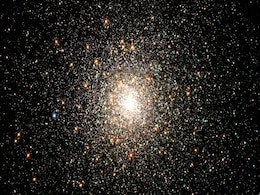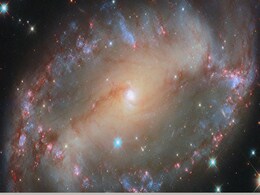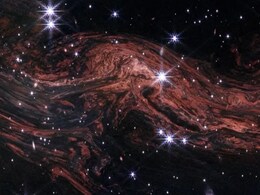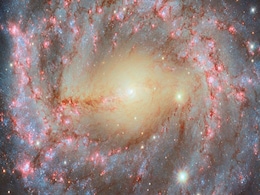Star Dust
- All
- News
- Videos
- Web Stories
-

Wolf-Rayet 104's Orbit Tilt Reduces Gamma-Ray Burst Threat, Study Finds
- Thursday March 20, 2025
- Written by Gadgets 360 Staff
New research using Keck Observatory’s instruments confirms that the orbit of Wolf-Rayet 104 is tilted 30-40 degrees away from Earth, lowering concerns about a possible gamma-ray burst. Previously, it was believed that the system’s alignment could pose a risk. However, spectroscopy data now challenges these assumptions, raising new questions abo...
-
 www.gadgets360.com
www.gadgets360.com
-

Hubble Captures Stunning Tarantula Nebula Image, Revealing Cosmic Dust and Star Formation
- Thursday February 27, 2025
- Written by Gadgets 360 Staff
A new image from the Hubble Space Telescope highlights the Tarantula Nebula’s complex structure, featuring dense cosmic dust clouds and vibrant star-forming regions. This nebula, located 160,000 light-years away, plays a vital role in understanding stellar evolution. The captured details offer insights into how cosmic dust contributes to star and...
-
 www.gadgets360.com
www.gadgets360.com
-

Hubble’s New Image of Tarantula Nebula Showcases Cosmic Dust and Star Formation
- Tuesday February 18, 2025
- Written by Gadgets 360 Staff
NASA/ESA’s Hubble Space Telescope has captured a breathtaking image of the Tarantula Nebula, located 160,000 light-years away in the Large Magellanic Cloud. The image reveals intricate cosmic dust patterns and active star formation, offering valuable insights into the role of interstellar material in stellar evolution. Researchers are using the d...
-
 www.gadgets360.com
www.gadgets360.com
-

JWST Unveils HH 30’s Protoplanetary Disk, Showing Dust Grains and Jets
- Monday February 10, 2025
- Written by Gadgets 360 Staff
The James Webb Space Telescope has captured an extraordinary image of HH 30, a protoplanetary disk in the Taurus constellation. The dense dust disk conceals the central star, while bright jets extend outward, interacting with surrounding gas. Microscopic dust grains within the disk have been identified, playing a crucial role in planetary formation...
-
 www.gadgets360.com
www.gadgets360.com
-

T Tauri's Great Dimming: Astronomers Study Young Star's Potential Disappearance
- Monday January 27, 2025
- Written by Gadgets 360 Staff
The young star T Tauri, located 471 light-years from Earth, is experiencing a significant dimming event. The cause is a thick dust and gas disk blocking its light, with astronomers predicting it may disappear from view for up to a century. This event presents an opportunity for scientists to explore the chemical makeup of planet-forming regions wit...
-
 www.gadgets360.com
www.gadgets360.com
-

Hubble Telescope Observes Young Stars HOPS 150 and HOPS 153 in Orion Nebula
- Wednesday January 22, 2025
- Written by Gadgets 360 Staff
The Hubble Space Telescope has captured images of two young stars, HOPS 150 and HOPS 153, in the Orion Nebula, which is located about 1,300 light-years from Earth. The binary system HOPS 150 glows in bright golden red, while HOPS 153 emits a colorful jet. These stars are still in their early stages of development, feeding from their surrounding dus...
-
 www.gadgets360.com
www.gadgets360.com
-

Hubble Telescope Captures Stunning View of Orion Nebula’s Protostars
- Monday January 20, 2025
- Written by Gadgets 360 Staff
The Hubble Space Telescope has captured a stunning view of the Orion Nebula, located 1,500 light-years from Earth. The new image highlights protostars HOPS 150 and HOPS 153, which are playing a key role in shaping their environment. These young stars are still in the process of formation, with the nebula's gas and dust feeding their growth. HOPS 15...
-
 www.gadgets360.com
www.gadgets360.com
-

James Webb Space Telescope Unveils Hidden Interstellar Wonders of Supernova Cassiopeia A
- Friday January 17, 2025
- Written by Gadgets 360 Staff
The James Webb Space Telescope has provided a rare glimpse into the remnants of a centuries-old supernova in Cassiopeia A. Using infrared technology, the telescope captured a light echo caused by a massive star’s explosion, unveiling new insights into the interstellar medium and its magnetic structures. This breakthrough discovery offers valuable...
-
 www.gadgets360.com
www.gadgets360.com
-

NASA's James Webb Space Telescope Shows 3D Structure Of Dust And Gas Between Stars
- Thursday January 16, 2025
- Science | Edited by NDTV News Desk
NASA's James Webb Space Telescope has captured highly detailed images showing the complex layers of interstellar dust and gas.
-
 www.ndtv.com
www.ndtv.com
-

James Webb Telescope Reveals Intricate Layers of Interstellar Dust And Gas, NASA Shares Image
- Thursday January 16, 2025
- Science | Edited by Ritu Singh
The initial findings offer novel perspectives on the relationship between star formation and the evolution of galaxies.
-
 www.ndtv.com
www.ndtv.com
-

Hidden Supermassive Black Holes Found Behind Gas and Dust Across the Universe
- Thursday January 16, 2025
- Written by Gadgets 360 Staff
Supermassive black holes, which feed on surrounding material, may be more common than earlier believed. Researchers suggest that nearly 30%-50% of these black holes could be concealed behind dense gas and dust, making them invisible to standard telescopes. The study, based on infrared observations, sheds light on how these entities influence star f...
-
 www.gadgets360.com
www.gadgets360.com
-

Webb Telescope Tracks Formation and Expansion of Carbon-Rich Dust Shells in Star System
- Thursday January 16, 2025
- Written by Gadgets 360 Staff
As per the latest report by NASA, the system consists of two stars in an elongated orbit. When these stars come closest, their stellar winds collide, compressing material and forming carbon-rich dust. As reported in an official press release by NASA, Emma Lieb, a doctoral student at the University of Denver and the study's lead author, noted that t...
-
 www.gadgets360.com
www.gadgets360.com
-

James Webb and Chandra Capture Images of Star Clusters in Distant Galaxies
- Thursday December 19, 2024
- Written by Gadgets 360 Staff
NASA’s James Webb Space Telescope and Chandra X-ray Observatory have unveiled stunning new images of two star clusters in the Small Magellanic Cloud. NGC 602, located approximately 200,000 light-years from Earth, showcases active star formation, with dust clouds and ionised gas revealing unique stellar birth conditions. Meanwhile, NGC 2264 featur...
-
 www.gadgets360.com
www.gadgets360.com
-

Hubble Captures NGC 5643’s Spiral Arms, Star Formation, and Hidden Black Hole
- Monday December 16, 2024
- Reported by Gadgets 360 Staff, Written by Gadgets 360 Staff
The NASA/ESA Hubble Space Telescope has captured detailed images of the spiral galaxy NGC 5643, located 40 million light-years away. This grand design galaxy features striking spiral arms outlined by young blue stars and dust clouds, with star-forming regions visible as pinkish hues. Ultraviolet and X-ray studies have revealed an active galactic nu...
-
 www.gadgets360.com
www.gadgets360.com
-

Arecibo Observatory Data Helps SETI Uncover Secrets of Pulsar Signals and Cosmic Distortions
- Tuesday December 10, 2024
- Written by Gadgets 360 Staff
Data from the now-collapsed Arecibo Observatory continues to drive major discoveries in space science. Sofia Sheikh and her team from the SETI Institute utilised archived data to investigate the signals of pulsars—dense neutron stars emitting radiation like cosmic lighthouses. Their study focused on how these signals are distorted by interstellar...
-
 www.gadgets360.com
www.gadgets360.com
-

Wolf-Rayet 104's Orbit Tilt Reduces Gamma-Ray Burst Threat, Study Finds
- Thursday March 20, 2025
- Written by Gadgets 360 Staff
New research using Keck Observatory’s instruments confirms that the orbit of Wolf-Rayet 104 is tilted 30-40 degrees away from Earth, lowering concerns about a possible gamma-ray burst. Previously, it was believed that the system’s alignment could pose a risk. However, spectroscopy data now challenges these assumptions, raising new questions abo...
-
 www.gadgets360.com
www.gadgets360.com
-

Hubble Captures Stunning Tarantula Nebula Image, Revealing Cosmic Dust and Star Formation
- Thursday February 27, 2025
- Written by Gadgets 360 Staff
A new image from the Hubble Space Telescope highlights the Tarantula Nebula’s complex structure, featuring dense cosmic dust clouds and vibrant star-forming regions. This nebula, located 160,000 light-years away, plays a vital role in understanding stellar evolution. The captured details offer insights into how cosmic dust contributes to star and...
-
 www.gadgets360.com
www.gadgets360.com
-

Hubble’s New Image of Tarantula Nebula Showcases Cosmic Dust and Star Formation
- Tuesday February 18, 2025
- Written by Gadgets 360 Staff
NASA/ESA’s Hubble Space Telescope has captured a breathtaking image of the Tarantula Nebula, located 160,000 light-years away in the Large Magellanic Cloud. The image reveals intricate cosmic dust patterns and active star formation, offering valuable insights into the role of interstellar material in stellar evolution. Researchers are using the d...
-
 www.gadgets360.com
www.gadgets360.com
-

JWST Unveils HH 30’s Protoplanetary Disk, Showing Dust Grains and Jets
- Monday February 10, 2025
- Written by Gadgets 360 Staff
The James Webb Space Telescope has captured an extraordinary image of HH 30, a protoplanetary disk in the Taurus constellation. The dense dust disk conceals the central star, while bright jets extend outward, interacting with surrounding gas. Microscopic dust grains within the disk have been identified, playing a crucial role in planetary formation...
-
 www.gadgets360.com
www.gadgets360.com
-

T Tauri's Great Dimming: Astronomers Study Young Star's Potential Disappearance
- Monday January 27, 2025
- Written by Gadgets 360 Staff
The young star T Tauri, located 471 light-years from Earth, is experiencing a significant dimming event. The cause is a thick dust and gas disk blocking its light, with astronomers predicting it may disappear from view for up to a century. This event presents an opportunity for scientists to explore the chemical makeup of planet-forming regions wit...
-
 www.gadgets360.com
www.gadgets360.com
-

Hubble Telescope Observes Young Stars HOPS 150 and HOPS 153 in Orion Nebula
- Wednesday January 22, 2025
- Written by Gadgets 360 Staff
The Hubble Space Telescope has captured images of two young stars, HOPS 150 and HOPS 153, in the Orion Nebula, which is located about 1,300 light-years from Earth. The binary system HOPS 150 glows in bright golden red, while HOPS 153 emits a colorful jet. These stars are still in their early stages of development, feeding from their surrounding dus...
-
 www.gadgets360.com
www.gadgets360.com
-

Hubble Telescope Captures Stunning View of Orion Nebula’s Protostars
- Monday January 20, 2025
- Written by Gadgets 360 Staff
The Hubble Space Telescope has captured a stunning view of the Orion Nebula, located 1,500 light-years from Earth. The new image highlights protostars HOPS 150 and HOPS 153, which are playing a key role in shaping their environment. These young stars are still in the process of formation, with the nebula's gas and dust feeding their growth. HOPS 15...
-
 www.gadgets360.com
www.gadgets360.com
-

James Webb Space Telescope Unveils Hidden Interstellar Wonders of Supernova Cassiopeia A
- Friday January 17, 2025
- Written by Gadgets 360 Staff
The James Webb Space Telescope has provided a rare glimpse into the remnants of a centuries-old supernova in Cassiopeia A. Using infrared technology, the telescope captured a light echo caused by a massive star’s explosion, unveiling new insights into the interstellar medium and its magnetic structures. This breakthrough discovery offers valuable...
-
 www.gadgets360.com
www.gadgets360.com
-

NASA's James Webb Space Telescope Shows 3D Structure Of Dust And Gas Between Stars
- Thursday January 16, 2025
- Science | Edited by NDTV News Desk
NASA's James Webb Space Telescope has captured highly detailed images showing the complex layers of interstellar dust and gas.
-
 www.ndtv.com
www.ndtv.com
-

James Webb Telescope Reveals Intricate Layers of Interstellar Dust And Gas, NASA Shares Image
- Thursday January 16, 2025
- Science | Edited by Ritu Singh
The initial findings offer novel perspectives on the relationship between star formation and the evolution of galaxies.
-
 www.ndtv.com
www.ndtv.com
-

Hidden Supermassive Black Holes Found Behind Gas and Dust Across the Universe
- Thursday January 16, 2025
- Written by Gadgets 360 Staff
Supermassive black holes, which feed on surrounding material, may be more common than earlier believed. Researchers suggest that nearly 30%-50% of these black holes could be concealed behind dense gas and dust, making them invisible to standard telescopes. The study, based on infrared observations, sheds light on how these entities influence star f...
-
 www.gadgets360.com
www.gadgets360.com
-

Webb Telescope Tracks Formation and Expansion of Carbon-Rich Dust Shells in Star System
- Thursday January 16, 2025
- Written by Gadgets 360 Staff
As per the latest report by NASA, the system consists of two stars in an elongated orbit. When these stars come closest, their stellar winds collide, compressing material and forming carbon-rich dust. As reported in an official press release by NASA, Emma Lieb, a doctoral student at the University of Denver and the study's lead author, noted that t...
-
 www.gadgets360.com
www.gadgets360.com
-

James Webb and Chandra Capture Images of Star Clusters in Distant Galaxies
- Thursday December 19, 2024
- Written by Gadgets 360 Staff
NASA’s James Webb Space Telescope and Chandra X-ray Observatory have unveiled stunning new images of two star clusters in the Small Magellanic Cloud. NGC 602, located approximately 200,000 light-years from Earth, showcases active star formation, with dust clouds and ionised gas revealing unique stellar birth conditions. Meanwhile, NGC 2264 featur...
-
 www.gadgets360.com
www.gadgets360.com
-

Hubble Captures NGC 5643’s Spiral Arms, Star Formation, and Hidden Black Hole
- Monday December 16, 2024
- Reported by Gadgets 360 Staff, Written by Gadgets 360 Staff
The NASA/ESA Hubble Space Telescope has captured detailed images of the spiral galaxy NGC 5643, located 40 million light-years away. This grand design galaxy features striking spiral arms outlined by young blue stars and dust clouds, with star-forming regions visible as pinkish hues. Ultraviolet and X-ray studies have revealed an active galactic nu...
-
 www.gadgets360.com
www.gadgets360.com
-

Arecibo Observatory Data Helps SETI Uncover Secrets of Pulsar Signals and Cosmic Distortions
- Tuesday December 10, 2024
- Written by Gadgets 360 Staff
Data from the now-collapsed Arecibo Observatory continues to drive major discoveries in space science. Sofia Sheikh and her team from the SETI Institute utilised archived data to investigate the signals of pulsars—dense neutron stars emitting radiation like cosmic lighthouses. Their study focused on how these signals are distorted by interstellar...
-
 www.gadgets360.com
www.gadgets360.com



















